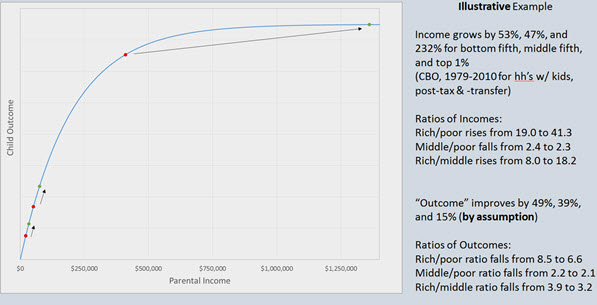The intuition that if something is bad it used to be better is completely understandable, but in the case of social mobility, it is probably wrong. Even before a deservedly lauded study by Harvard economist Raj Chetty came out in January, the safest conclusion from the sizable literature on income, occupational, and educational mobility was that any changes in intergenerational mobility since the mid-twentieth century have been small enough that we cannot reliably detect them.
How can this be, given the well-publicized growth in inequalities between children who grow up rich or poor? Five possible factors:
- Some gaps may have grown less than is widely believed, if at all. Income inequality between the poor and middle class has increased only modestly, and income concentration at the top has also probably not grown as much as the most widely-cited estimates suggest. The evidence of whether test-score gaps have grown is actually mixed.
- Some growing inequalities may not be important for mobility. It’s not obvious, for example, that growing gaps in school extracurricular participation will lead to diminished mobility.
- Gaps in mobility-promoting resources can widen even as poor and middle class children enjoy more of those resources. College graduation rates have risen even among poor children, just not as much as they have for rich children. The incomes of the poor and middle class families with children have risen substantially over the past 35 years, just not as much as at the top.
- When gaps in resources are already large and the benefits of having more resources diminish rapidly, widening gaps can actually lead to more equal outcomes. This is particularly the case if we measure outcome inequality by looking at the ratio of rich-to-poor outcomes rather than the difference, as shown in the chart below. For example, if what matters in comparing college graduation rates between rich and poor children is how many times higher the former is relative to the latter (rather than how many percentage points higher), then inequality in college graduation between rich and poor children has actually declined.

- While some trends point to diminished mobility, many work in favor of improving mobility. Poverty has declined. Income inequality between the poor and middle class has stopped rising, and income concentration may even have stabilized. Discrimination, while not having disappeared, is much less pervasive. Teen births have plummeted, and unwanted births have fallen. Rising incarceration rates reduced the number of high-criminality individuals in poor neighborhoods, crime has fallen dramatically, and drug use is less common. Exposure to lead has declined. Health care access has expanded. Even the college graduation gap between rich and poor children has stabilized.
Rather than advocating for more upward mobility because opportunity has become more unequal (or is becoming so), we should want more mobility because opportunity is too unequal. It matters little whether things are getting worse when only 30 percent of poor children make it to the middle class as adults.


Commentary
The Persistent—if Insufficient— American Dream
February 28, 2014